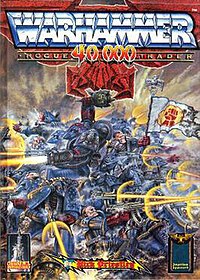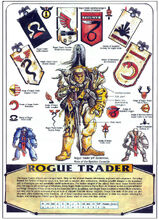 |
| Rule Book front cover |
The gameplay of Warhammer 40,000: Rogue Trader differs from its main modern-day descendant (Warhammer 40,000), in that it was heavily role-play-oriented, with great detail placed on weaponry and vehicles and the inclusion of a third player (the Game Master) in battles, a role not too different from the Dungeon Master of Dungeons and Dragons. Rogue Trader game introduced some races that were later removed from the Warhammer 40,000 setting, such as Squats (Warhammer dwarfs in space), Zoats (also present in Warhammer Fantasy Battle) and the Space Slann (a humanoid frog-like race).
Models which were released for Rogue Trader are no longer produced and are available in private collections with limited remaining stocks available on the Games Workshop online store.
Like many later incarnations the Rogue Trader rulebook mostly contained what is often termed 'fluff', i.e. the historical background of the Imperium and alien races. Information on the Warp was limited and the forces of Chaos were nowhere to be seen; but they were referred to by game designer Rick Priestly in the pre-release announcement, and they did show up shortly after in expansion rulebooks which provided not just greater background for the various races and armies but also the first proper army lists. Only a small portion of the book contained rules, with a large number of pages devoted the background of the universe. The fact that the current edition still contains a great amount of 'fluff' is a testament to the popularity of this arrangement.
Games Workshop's current management has been somewhat reluctant to refer to Rogue Trader in modern publications, choosing not to have parallels drawn between their current products and the somewhat more whimsical and tongue-in-cheek style that they practised in the 1980s and 1990s. However, the opening text was nonetheless highly similar to the later editions and of the opening texts of Black Library publications.
Also illustrative of the style is that the inside covers of the book were decorated with caricatures of members of Games Workshop staff.
Character class
The rule book originally described Rogue Traders as being freelance explorers employed by the Imperium to search for planets outside of the established borders. A Rogue Trader is a trusted Imperial servant, given a ship, a crew, a contingent of marines and the right to go wherever they so desire. They generally survey uninhabited worlds near to the fringes of Imperial space and on the Eastern Fringes where the Astronomican does not reach.
The potentials of new worlds, such as material wealth or knowledge, has stimulated the growth of the Rogue Trader section of society. Some have even gone so far as to try to cross intergalactic space, although even a mighty psyker is not powerful enough to send back reports from that distance. When encountering new alien species, the Rogue Trader is very much a separate organisation from the Imperium, so they must decide how to react to these new creatures. If they judge them unworthy they can be destroyed or they can gather information on them and have someone else destroy them. If he deems them useful, he may make contact with them. If they are only useful for their technology or material wealth then they may be raided, the trader returning to Terra laden with rich goods and undreamed of technology.
A Rogue Trader can be in charge of up to a dozen ships, including many transports with willing colonists and troops. They tend to be individuals who have reached a certain height in the Imperium but for some reason are not considered fit for further advancement. By being offered Rogue Trader status, they can be put somewhere out of harm's reach, though it strengthens their reputation as outcasts. They can include overzealous Space Marine Commanders, powerful navigators and even Inquisitors.
This profile has been altered as the game (and Warhammer 40,000 universe) evolved. For example, in many of the more recent Warhammer 40,000 novels, many Rogue Traders have been depicted as independent traders who tend to smuggle highly illegal or dangerous contraband by running Imperial blockades. Some of these items include, but are not limited to, narcotics, alien technology, and warp-tainted items. However, some Rogue Traders are more sympathetic to the Imperium, and many Imperial agents such as Inquisitors employ Rogue Traders when they require fast and stealthy transportation.
Yet more recent canon depicts the Rogue Traders as an amalgam of the two previous versions. Rogue Traders are given a writ from the Imperium, much like a privateers, to explore beyond the boundaries of Imperial Space. This writ passes to the Trader's descendants. The Rogue Trader and his family, and the vessels they command, which can comprise a small fleet in some cases, are exempt from many Imperial laws and regulations, but is still under Imperial scrutiny. Rogue traders that dabble too heavily in alien trade, or other "heretical" practices, could still be investigated and executed by the Inquisition.


No comments:
Post a Comment